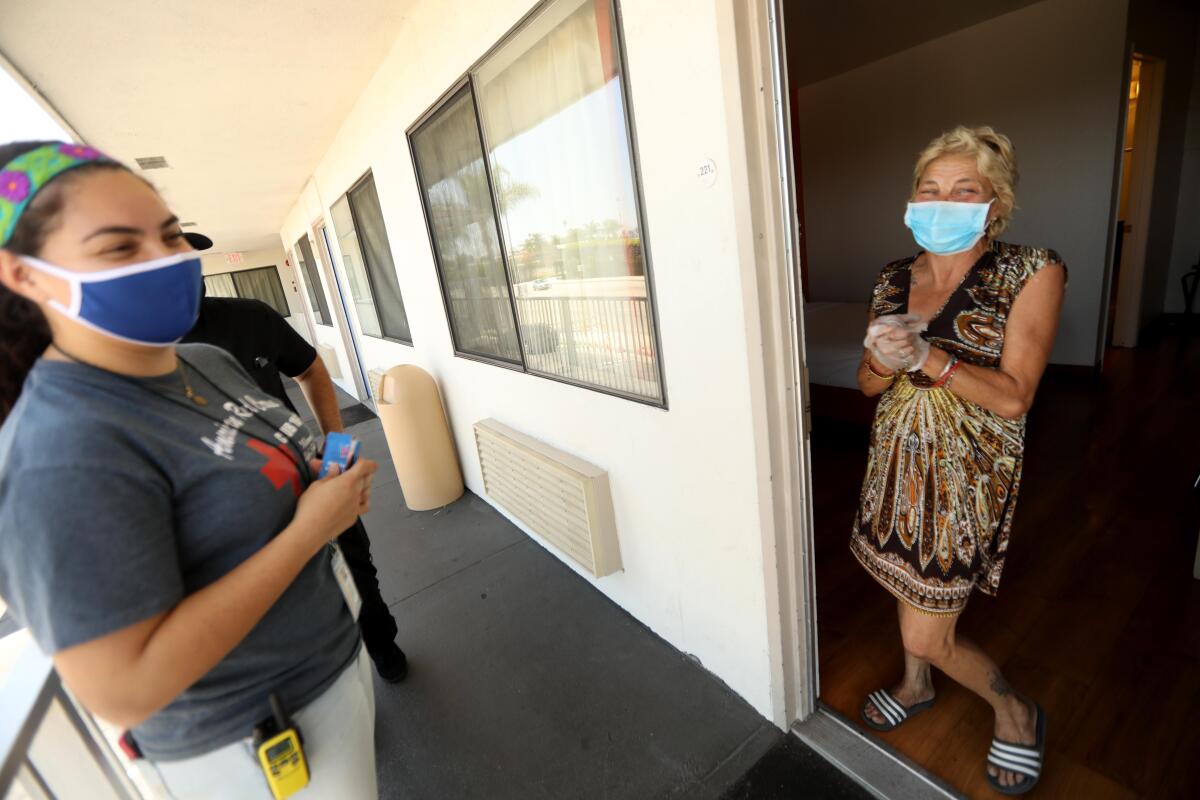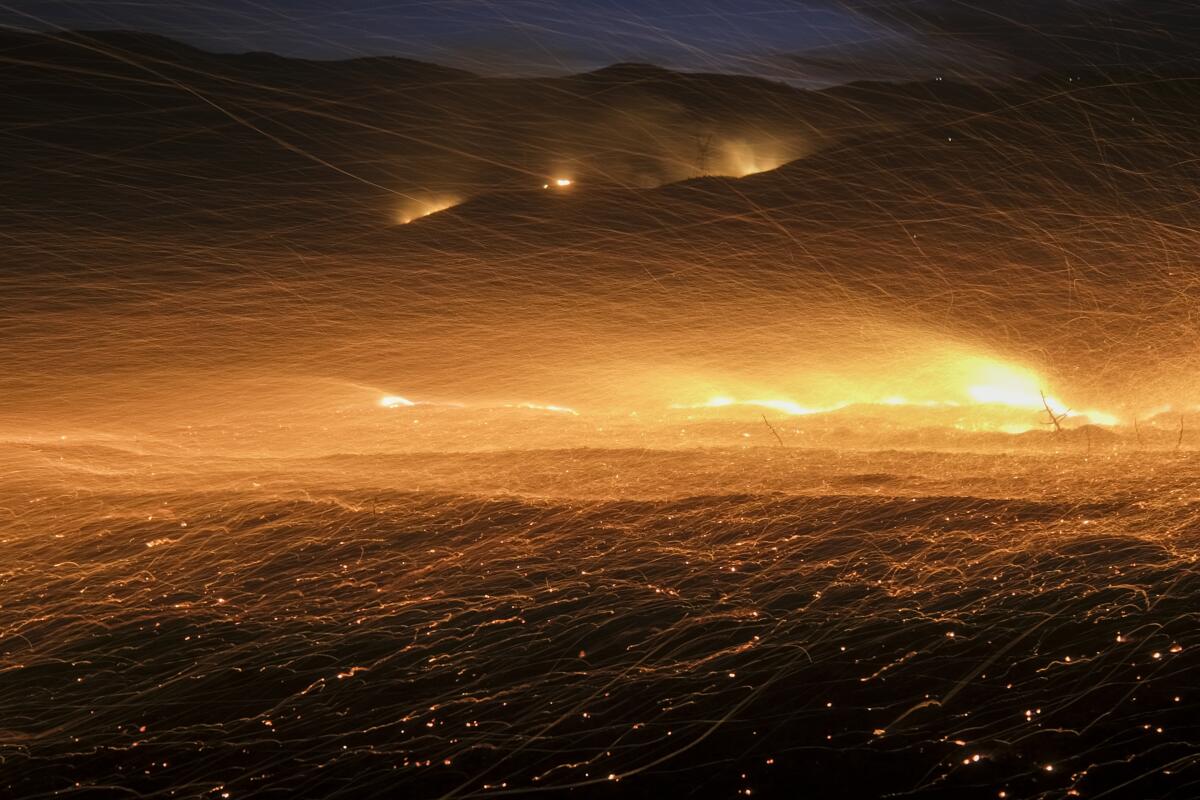Project Roomkey was meant to ‘protect human life.’ A new report tracks its performance

Good morning. It’s Wednesday, May 15. Here’s what you need to know to start your day.
- Evaluating California’s pandemic program to shelter unhoused people
- Wildfire season approaches. Is California ready?
- Need a couch? These are made in L.A.
- And here’s today’s e-newspaper
You're reading the Essential California newsletter
Our reporters guide you through our biggest news, features and recommendations every morning
You may occasionally receive promotional content from the Los Angeles Times.
Evaluating California’s pandemic program to shelter unhoused people
When the COVID-19 pandemic upended daily life a little over four years ago, state and local health officials were particularly concerned about the coronavirus spreading rapidly among unhoused Californians.
In response, state agencies mobilized quickly to create and launch Project Roomkey, repurposing hotel and motels to provide rooms to unhoused people. The goal of the emergency project was “to protect human life, and to minimize strain on health care system capacity.”
So, how much did Project Roomkey (which I’ll just call PRK moving forward) actually help? A newly released study from research and consulting firm Abt Global attempted to answer that question.
While the study highlights some success in the context of a global health emergency, it also notes shortfalls in later goals aimed at providing its clients with permanent housing.
The study was funded by the California Health Care Foundation and the Conrad N. Hilton Foundation. Researchers collected online survey data from providers in 45 counties, conducted phone interviews with providers in 15 counties and visited sites in five counties, where they interviewed 67 current and former clients of the program.
Their conclusion: PRK achieved its original goals of saving lives and easing pressure on an already overstrained healthcare system. The authors also said the project “enhanced how interim housing is designed and operated in some communities across California.”
But the study comes with a major asterisk, L.A. Times reporter Doug Smith noted in his recent coverage: the “inability to connect information collected at the hotel and motel sites with statewide data from health, housing and other public services agencies left the researchers with only anecdotal evidence to substantiate that conclusion.”
That echoes an ongoing challenge in California’s extensive response to the homelessness crisis: the state does a poor job of tracking how billions of dollars in funding is being spent or how well it’s working.
In total, PRK provided hotel rooms to about 62,000 people in 50 counties and four tribal jurisdictions across the state. The study authors note that the program peaked in October 2020 with more than 16,000 committed rooms, but began to fall off after that.
In L.A. for instance, the program ended in early 2021 after falling well short of its goals. When Mayor Karen Bass took office in late 2022, she launched Safe Inside, which followed a similar strategy of providing temporary rooms with the hopes of permanent housing down the line. Progress has been slow.
Lackluster progress on housing
While PRK was initially launched to boost emergency shelter options across the state, it later evolved to include a rehousing strategy to “ensure no Project Roomkey occupant is forced to exit into unsheltered homelessness,” according to state officials.
But most of PRK’s clients did not trade their temporary room for a permanent home. The authors note that of the 62,000 people who received a California hotel or motel room through the program:
- 25% moved into other emergency shelter sites
- 23% were unaccounted for
- 22% moved in to permanent housing (subsidized or unsubsidized)
- 11% moved in temporarily with friends or family or to transitional housing or motels
- 15% returned to the street
- 4% transferred to institutions such as hospitals, nursing homes or substance abuse treatment facilities
The report also states that longer stays in PRK-funded hotels or motels led to a higher likelihood of permanent housing for people, but other temporary shelters often outperformed PRK sites.
“In the three counties for which they had data on individuals, the researchers found that residents in traditional shelters were more likely to obtain permanent housing,” Doug reported. “In Los Angeles only 19% of Project Roomkey clients moved on to permanent homes, compared with 25% of those leaving shelters.”
It’s also worth noting that while study authors highlight the program’s success at reducing the number of unhoused people getting sick and dying due to the coronavirus, deaths in the unhoused community have increased dramatically in the past several years — even before the pandemic.
Drug overdoses play a major role in those deaths, which have been rising each year in many counties, including Los Angeles and San Diego. But people experiencing homelessness are also dying at higher rates due to heat and cold exposure, traffic collisions and complications from cardiovascular disease and diabetes. Adding to the problem is the fact that the available mortality data are incomplete, meaning the numbers that do get reported are almost certainly an undercount.
The achievements and challenges of Project Roomkey mirror much of what I’ve heard from homelessness experts and advocates for the unhoused:
The systems meant to respond to and reduce homelessness are mostly failing to get people on paths to secure housing. Part of the problem is that homeless service providers don’t control how much housing is getting built in communities — or how many of those homes are affordable to the extremely poor.
And that’s the real solution to our homelessness crisis that temporary rooms don’t achieve on their own, but can help forge a path to: permanent, affordable housing for the more than 180,000 unhoused people (and counting) who need it in the Golden State.
You can read more of Doug Smith’s reporting on the Project Roomkey study here.
Today’s top stories

Wildfires
- Wildfire weather is increasing in California and much of the U.S., a report finds.
- L.A.’s water supplies are in good shape. But is the city ready for the next drought?
Violence on the metro
- Three people were stabbed in two separate incidents on Los Angeles County’s Metro system.
- Column: They want to ride buses and trains, but they’re afraid. For riders old and young, Metro must be safer.
Hepatitis A outbreak
- Hepatitis A is spreading among Los Angeles homeless population, health officials say.
- Hepatitis A scare at the Men’s Central Jail led to more than 1,500 vaccinations.
- Opinion: A deadly but curable disease is thriving in L.A.’s jails. That’s unacceptable.
Crime and courts
- It took a month to ID a law school student’s body. Her fiancé has now been convicted of murder.
- Gunshots fired at an Oakland teen rowing team don’t stop it from finishing the race.
- The shooter of two Jewish men in L.A. agrees to plead guilty to hate crimes.
More big stories
- What you need to know about the bird flu outbreak, concerns about raw milk, and more.
- Climate change is central to both Pope Francis and Newsom. But do Catholic voters care?
- Alice Munro, acclaimed short-story writer and Nobel Prize winner, dies at 92.
- Summer of 2023 was hottest in 2,000 years, a study finds.
- SpaceX plans to launch 90 rockets from Vandenberg Space Force Base by 2026. Could that harm the coast?
- East West Players appoints Lily Tung Crystal as its new artistic director.
- Red Lobster offered all-you-can-eat shrimp. That was a mistake.
- Harry and Meghan’s Archewell Foundation was ‘delinquent’ in California. What does that mean?
- Drownings rose among young children after decades of decline. It’s ‘highly concerning,’ CDC says.
- Pro-Palestinian activists protest at Google developer conference amid Israel-Hamas war.
- New York is on a studio building spree to grab a bigger slice of L.A.’s Hollywood pie.
- Buying a home in Southern California? There are now more options.
- Gov. Kristi Noem, who wrote of shooting her dog, to speak at California GOP convention.
Get unlimited access to the Los Angeles Times. Subscribe here.
Commentary and opinions
- Robin Abcarian: ‘Diaper Don’? Trump’s supporters turn the tables on his puerile critics.
- Mariel Garza: Dislike Tesla? OK, but here’s why you should love its Superchargers.
- Sammy Roth: California farmers are low on water. Why not help them go solar?
- Michael Hiltzik: Exxon Mobil is suing its shareholders to silence them about global warming.
Today’s great reads
A lonely desert fire station, the only lifeline for millions of Vegas travelers. Expect to wait for help if you crash in the desert Interstate 15 from Los Angeles to Vegas. There’s only one fire station dedicated to the stretch. Last year, the five-person crew answered nearly 1,000 calls.
Other great reads
- Renting used to be a source of shame to this apartment manager’s daughter. Now it’s a knowing comfort.
- ChatGPT’s new voice mode is giving ‘Her’ vibes.
- Want to live to 100? That may depend on your sex.
How can we make this newsletter more useful? Send comments to essentialcalifornia@latimes.com.
For your downtime

Going out
- 🛋️ The best shops for couches made in Los Angeles.
- 🍴Where every cent of $1 goes at one L.A. restaurant, explained.
- 🎭 Las Vegas’ new must-see show plays with animation, dance and what it means to be human.
Staying in
- 📖 Miranda July is widening and expanding women’s lives with her new novel: ‘Fiction is my superpower.’
- 🧑🍳 Here’s a recipe for grilled swordfish with quick crushed potatoes and parsley-caper relish.
- ✏️ Get our free daily crossword puzzle, sudoku, word search and arcade games.
And finally ... a great photo
Show us your favorite place in California! We’re running low on submissions. Send us photos that scream California and we may feature them in an edition of Essential California.
Today’s great photo is from Times photographer Christina House. House snapped this photo of actor Jonathan Bailey in downtown L.A.
Have a great day, from the Essential California team
Ryan Fonseca, reporter
Kevinisha Walker, multiplatform editor and Saturday reporter
Christian Orozco, assistant editor
Karim Doumar, head of newsletters
Check our top stories, topics and the latest articles on latimes.com.
Sign up for Essential California
The most important California stories and recommendations in your inbox every morning.
You may occasionally receive promotional content from the Los Angeles Times.






